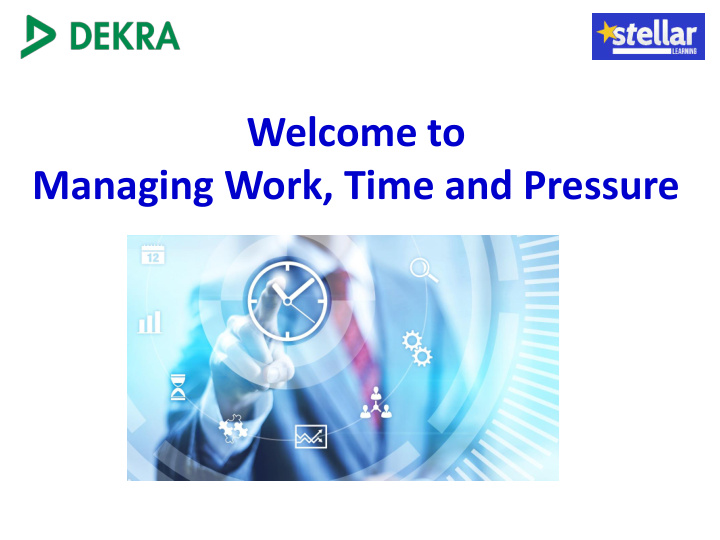



Welcome to Managing Work, Time and Pressure
Session 1 – Practical Tools
2
Remember This?
Challenges, Strengths and Objectives • What are your greatest time management challenges and pressures? • Your greatest strengths when managing time and energy • Your personal learning objectives for today?
Analyse Your Use of Time p4
Prioritising with The Covey Time Management Matrix
Time Budgeting How much time is available in the working week? If you have 40 hours, how will you use them? Example Hours Meetings and travel 5 Admin desk time 3 Responding to requests 5 Reading & research 3 Flexibility for unexpected 5 What is left for key objectives? Only 19 hours!
Scheduling Tips Planning nning is an inten ention. tion. Schedu heduling ling is the e se secr cret et of making ing things ngs happen! pen! Block out time to tackle big important jobs Group related items and actions Schedule quiet time Set time limits for everything you do Keep 20% of your time unscheduled, to allow for the unexpected Plan and schedule the next week on Friday afternoon Check and adjust your schedule for the next day before you leave What t do you do/cou could ld you do?
Reflection, Review & Action P11
Session 2 – Understanding the Science and Additional Strategies
Welcome Back! 1. Wins and Challenges since session 1 2. Personal learning objectives for today
40 40 – 50% 50%
“What fir ires es to together ether, wi wires es 66 together” Hebb’s Law
What unresourceful habits might you have fallen into at work?
Habit Triggers and Cues What are some habitual responses you would like to change?
The Reactive/Proactive Continuum Proactive Reactive Go with the flow Plan ahead React to events Schedule life
Realising the Vision Organisation’s Vision Business Objectives Department or Project Objectives Team Objectives Individual Objectives
Objectives How aligned are they? To what extent do they complement or conflict? Do they fulfil the S.M.A.R.T.I.E. criteria?
Pl Planning anning Fallac llacy y Bias ias 1963 963 $7m 1973 973 $102m 02m
Implementation Intentions IF IF Away Towards from pleasure pain THEN THEN “If I don’t finish this “If I finish this report on report on time I won’t time I’ll go the pictures” have a drink tonight”
Implementation Intentions WH WHEN EN THEN THEN “When the alarm goes off on Monday, Wednesday and Friday I will go the gym – no excuses” “When someone asks if I have a minute I will offer them an option – every time”
Managing Energy Peak Peak Performance Performance Activity Level 90 min 90 ins 90 90 min ins 20 20 20 20 20 20 mins ns mins ns mins ns R&R R&R R&R Time R&R = recovery and renewal
The ‘NOT TO DO’ List (Tim Ferriss) Say “yes” if you Work more to fix Email first AM or can’t deliver overwhelm last thing PM Try to please Agree to meetings everyone or calls without a clear agenda or end time Create a list you know you can’t Send email complete responses when Be wedded to in a bad mood! Eat ‘ al desko ’! your phone
Session 3 – Working with Others for Increased Productivity
Welcome Back! 1. Wins and Challenges since sessions 1 & 2 2. Personal learning objectives for today
Working with Others – an Honest Conversation • What are our expectations of others? • How realistic are they? • How might our actions and behaviour adversely impact others’ ability to do their job • What action can we take to help others manage their time and workload more effectively?
Saying NO – The 4D Way DO it - say YES DATE it – decide when to meet DELEGATE it – usually back to the DUMP it – just say NO person who created it in the first place
Handling Interruptions • Face away from the flow • Keep conversation short • Stand up • Fix a time • Invent an appointment • Book quiet time with yourself • Agree a signal with colleagues to show you don’t want to be interrupted.
Reflection, Review & Action
Recommend
More recommend